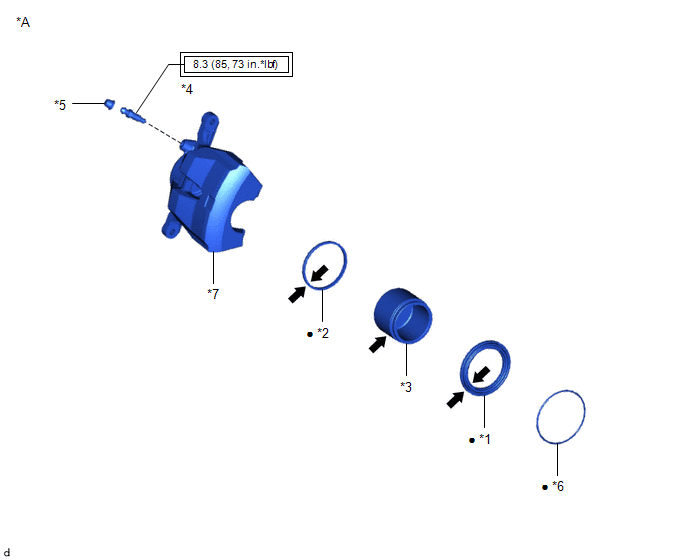Toyota Yaris: Introduction / How To Use This Manual
General Information
GENERAL INFORMATION
GENERAL DESCRIPTION
(a) This manual is written in accordance with SAE J2008.
(b) Repair operations can be separated mainly into the following 3 processes:
(1) Diagnosis
(2) Removing/Installing, Replacing, Disassembling/Reassembling, Checking and Adjusting
(3) Final Inspection
(c) The following procedures are omitted from this manual. However, these procedures must be performed.
(1) Use a jack or lift to perform operations.
(2) Clean all removed parts.
(3) Perform a visual check before and after performing any work.
PREPARATION
(a) Use of Special Service Tools (SST) and Special Service Materials (SSM) may be required, depending on the repair procedure. Be sure to use SST and SSM when they are required and follow the work procedure properly. A list of SST and SSM is in the "Preparation" section of this manual.
REPAIR PROCEDURES
(a) A component illustration is placed under the title where necessary.
(b) Non-reusable parts, grease application areas, precoated parts and torque specifications are noted in the component illustrations.
- The following illustration is an example.
| Symbol | Contents |
|---|---|
 | Tightening torque for "Major areas involving basic vehicle performance such as moving/turning/stopping": N*m (kgf*cm, ft.*lbf) |
 | N*m (kgf*cm, ft.*lbf): Specified torque |
| ● | Non-reusable part |
| ★ | Precoated part |
 | Apply Lubricant Here |
 | Do not apply lubricants to the threaded parts |
CAUTION:
"Major areas involving basic vehicle performance such as moving/turning/stopping" indicates areas that require a higher degree of precision when tightening.

| *A | Example | - | - |
| *1 | CYLINDER BOOT | *2 | PISTON SEAL |
| *3 | FRONT DISC BRAKE PISTON | *4 | FRONT DISC BRAKE BLEEDER PLUG |
| *5 | FRONT DISC BRAKE BLEEDER PLUG CAP | *6 | SET RING |
| *7 | DISC BRAKE CYLINDER ASSEMBLY LH | - | - |
 | Tightening torque for "Major areas involving basic vehicle performance such as moving/turning/stopping": N*m (kgf*cm, ft.*lbf) |
 | N*m (kgf*cm, ft.*lbf): Specified torque |
| ● | Non-reusable part |
 | Lithium soap base glycol grease |
(c) Torque specifications, grease application areas and non-reusable parts are emphasized in the procedures.
HINT:
There are cases where such information can only be explained by using an illustration. In these cases, torque, oil and other information are described in the illustration.
(d) Only items with key points are described in the text. What to do and other details are explained using illustrations next to the text. Both the text and illustrations are accompanied by standard values and notices.
| Illustration | What to do and where to do it |
| Task heading | What work will be performed |
| Explanation text |
|
(e) Illustrations of similar vehicle models are sometimes used. In these cases, minor details may be different from the actual vehicle.
(f) Procedures are presented in a step-by-step format.
SERVICE SPECIFICATIONS
(a) Specifications are presented in boldface text throughout the manual. The specifications are also found in the "Specifications" section for reference.
TERM DEFINITIONS
| CAUTION | Possibility of injury to you or other people |
| NOTICE | Possibility of damage to components being repaired |
| HINT | Provides additional information to help you perform repairs |
INTERNATIONAL SYSTEM OF UNITS
(a) The units used in this manual comply with the International System of Units (SI UNIT) standard. Other units from the metric system and the English system are also provided.
- Example:
Torque:
30 N·m {306 kgf·cm, 22 ft·lbf}
 How To Proceed With Troubleshooting
How To Proceed With Troubleshooting
HOW TO PROCEED WITH TROUBLESHOOTING OPERATION FLOW HINT: Perform troubleshooting in accordance with the procedure below. The following is an outline of basic troubleshooting procedure...
 Identification Information
Identification Information
Vehicle Identification And Serial NumbersVEHICLE IDENTIFICATION AND SERIAL NUMBERS VEHICLE IDENTIFICATION NUMBER (a) The vehicle identification number is stamped on the vehicle body and on the certification label or name label as shown in the illustration...
Other information:
Toyota Yaris XP210 (2020-2025) Reapir and Service Manual: Front Blower Motor
ComponentsCOMPONENTS ILLUSTRATION *1 NO. 2 INSTRUMENT PANEL UNDER COVER SUB-ASSEMBLY *2 BLOWER MOTOR WITH FAN SUB-ASSEMBLY RemovalREMOVAL PROCEDURE 1. REMOVE NO. 2 INSTRUMENT PANEL UNDER COVER SUB-ASSEMBLY Click here 2. REMOVE BLOWER MOTOR WITH FAN SUB-ASSEMBLY (a) Disconnect the connector...
Toyota Yaris XP210 (2020-2025) Owner's Manual: Replacing Exterior Light Bulbs
Headlights/Daytime running lights (With halogen headlights) Make sure the ignition is switched off, and the headlight switch is off. Lift the hood. Disconnect the connector from the bulb. Detach the sealing cover from the bulb. Retaining spring Sealing cover Unhook the bulb retaining spring...
Categories
- Manuals Home
- Toyota Yaris Owners Manual
- Toyota Yaris Service Manual
- Engine Start Function When Key Battery is Dead
- Immobilizer System
- Maintenance
- New on site
- Most important about car
Supplemental Restraint System (SRS) Precautions
The front and side supplemental restraint systems (SRS) include different types of air bags. Please verify the different types of air bags which are equipped on your vehicle by locating the “SRS AIRBAG” location indicators. These indicators are visible in the area where the air bags are installed.
The air bags are installed in the following locations:
The steering wheel hub (driver air bag) The front passenger dashboard (front passenger air bag) The outboard sides of the front seatbacks (side air bags) The front and rear window pillars, and the roof edge along both sides (curtain air bags)